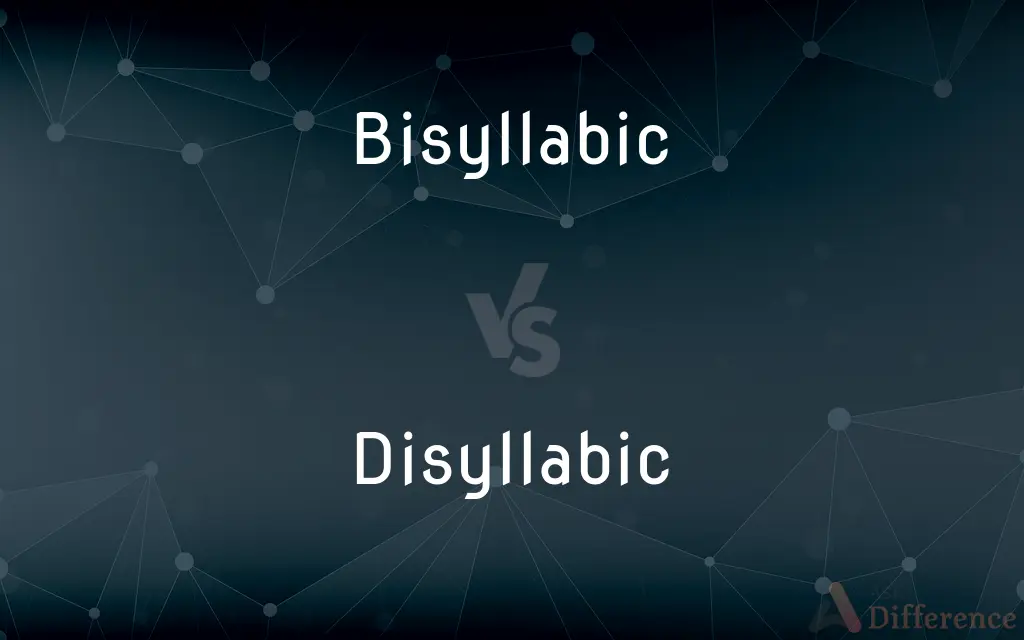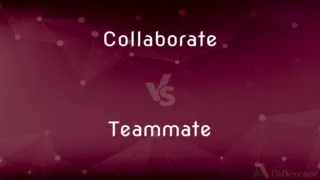Bisyllabic vs. Disyllabic — What's the Difference?
By Tayyaba Rehman & Fiza Rafique — Updated on March 29, 2024
Both bisyllabic and disyllabic refer to words with two syllables, but "bisyllabic" is less commonly used than "disyllabic" in linguistic contexts.

Difference Between Bisyllabic and Disyllabic
Table of Contents
ADVERTISEMENT
Key Differences
Bisyllabic and disyllabic are terms used in linguistics to describe words that consist of two syllables. While both terms have the same meaning, "disyllabic" is more commonly used in linguistic studies and discussions to specify words of two syllables. "Bisyllabic," though correct, is less frequently encountered in linguistic literature.
The use of "disyllabic" often comes in the context of analyzing word structures, phonetics, and metrics in poetry, where the syllable count plays a crucial role. On the other hand, "bisyllabic" might be used in broader discussions that encompass linguistics but also delve into areas like psychology and neurology, especially when discussing the processing and perception of language.
Both terms help in the classification and analysis of words according to their syllabic structure, which is essential in the study of phonology, the subdivision of linguistics that deals with the sound system of languages. This classification aids in understanding language patterns, pronunciation, and the rhythmic qualities of speech and writing.
Despite their interchangeable meanings, the preference for "disyllabic" in linguistic contexts might stem from its specificity and consistency with other terms in the field, such as "monosyllabic" for one syllable, "trisyllabic" for three syllables, and "polysyllabic" for more than one syllable, typically referring to words with four or more syllables.
In practical usage, understanding the distinction between bisyllabic and disyllabic is less about their definition, which is the same, and more about recognizing that "disyllabic" is the preferred term in linguistic studies. Both terms, however, play a role in the nuanced study and appreciation of language, contributing to our understanding of word structures and their impact on communication.
ADVERTISEMENT
Comparison Chart
Definition
Refers to words with two syllables.
Refers to words with two syllables.
Usage
Correct but less common.
More commonly used in linguistic contexts.
Contexts
Used broadly, including linguistics.
Preferred in linguistics and poetry analysis.
Examples
"Water," "table," and "garden" are bisyllabic.
"Water," "table," and "garden" are disyllabic.
Associated Fields
Linguistics, psychology, neurology.
Linguistics, phonetics, poetry.
Compare with Definitions
Bisyllabic
Words composed of two syllables.
Coffee is a bisyllabic word.
Disyllabic
Words consisting of two syllables.
Window is a disyllabic word.
Bisyllabic
Bisyllabic words are common across many languages, providing a basis for comparative linguistics.
Comparing bisyllabic words in English and Spanish can reveal interesting linguistic patterns.
Disyllabic
Plays a critical role in the study of sound patterns in languages.
Disyllabic words are analyzed for stress patterns in phonology studies.
Bisyllabic
While accurate, it's less prevalent in specialized linguistic discussions.
In a study on language perception, researchers might refer to coffee and sugar as bisyllabic words.
Disyllabic
Widely used in linguistic, phonetic, and poetic analyses.
Poets often use disyllabic words to maintain a poem's meter.
Bisyllabic
Important for understanding word structure and syllable distribution.
Bisyllabic words play a significant role in the rhythm of spoken language.
Disyllabic
Aids in comparing the syllable structure of different languages.
Disyllabic words offer insights into the morphological complexity of languages.
Bisyllabic
Useful in education and language learning, aiding in the teaching of pronunciation and spelling.
Learners often start with bisyllabic words when practicing pronunciation.
Disyllabic
Essential for understanding the rhythmic structure in poetry and prose.
The use of disyllabic words can alter the flow and emphasis in verse.
Bisyllabic
Comprising two syllables.
Disyllabic
A word with two syllables.
Disyllabic
Comprising two syllables.
Disyllabic
A word consisting of two syllables
Disyllabic
Having or characterized by or consisting of two syllables
Common Curiosities
What does bisyllabic mean?
Bisyllabic describes words that have two syllables.
Can you give examples of bisyllabic/disyllabic words?
Examples include "apple," "orange," and "flower." Each of these words contains two syllables.
Are bisyllabic and disyllabic interchangeable?
Yes, both terms can be used interchangeably to describe two-syllable words, though "disyllabic" is preferred in linguistic studies.
Is there a reason to prefer one term over the other in academic writing?
In academic writing, especially in linguistics and phonetics, "disyllabic" is preferred for its consistency with related terminology.
How does the study of disyllabic words contribute to poetry analysis?
Analyzing disyllabic words helps in understanding meter and rhythm in poetry, as the syllable count influences the poem's flow and emphasis.
What does disyllabic mean?
Disyllabic also describes words that consist of two syllables, and is the term more commonly used in linguistic contexts.
Why is disyllabic more commonly used than bisyllabic?
"Disyllabic" is more consistent with the terminology used in linguistics and phonetics, aligning with terms like monosyllabic and trisyllabic.
How are bisyllabic and disyllabic words important in language studies?
They are crucial for understanding syllable distribution, word stress patterns, and the rhythmic qualities of language in both spoken and written forms.
Do bisyllabic and disyllabic words have the same importance in all languages?
While the concept is universally applicable, the frequency and phonological significance of two-syllable words vary among languages, reflecting different linguistic structures and patterns.
Can the classification of a word as bisyllabic or disyllabic change?
The classification based on syllable count remains constant, but pronunciation variations can affect how syllables are perceived or articulated in different dialects or accents.
Share Your Discovery

Previous Comparison
Collaborate vs. Teammate
Next Comparison
Forage vs. GatherAuthor Spotlight
Written by
Tayyaba RehmanTayyaba Rehman is a distinguished writer, currently serving as a primary contributor to askdifference.com. As a researcher in semantics and etymology, Tayyaba's passion for the complexity of languages and their distinctions has found a perfect home on the platform. Tayyaba delves into the intricacies of language, distinguishing between commonly confused words and phrases, thereby providing clarity for readers worldwide.
Co-written by
Fiza RafiqueFiza Rafique is a skilled content writer at AskDifference.com, where she meticulously refines and enhances written pieces. Drawing from her vast editorial expertise, Fiza ensures clarity, accuracy, and precision in every article. Passionate about language, she continually seeks to elevate the quality of content for readers worldwide.















































